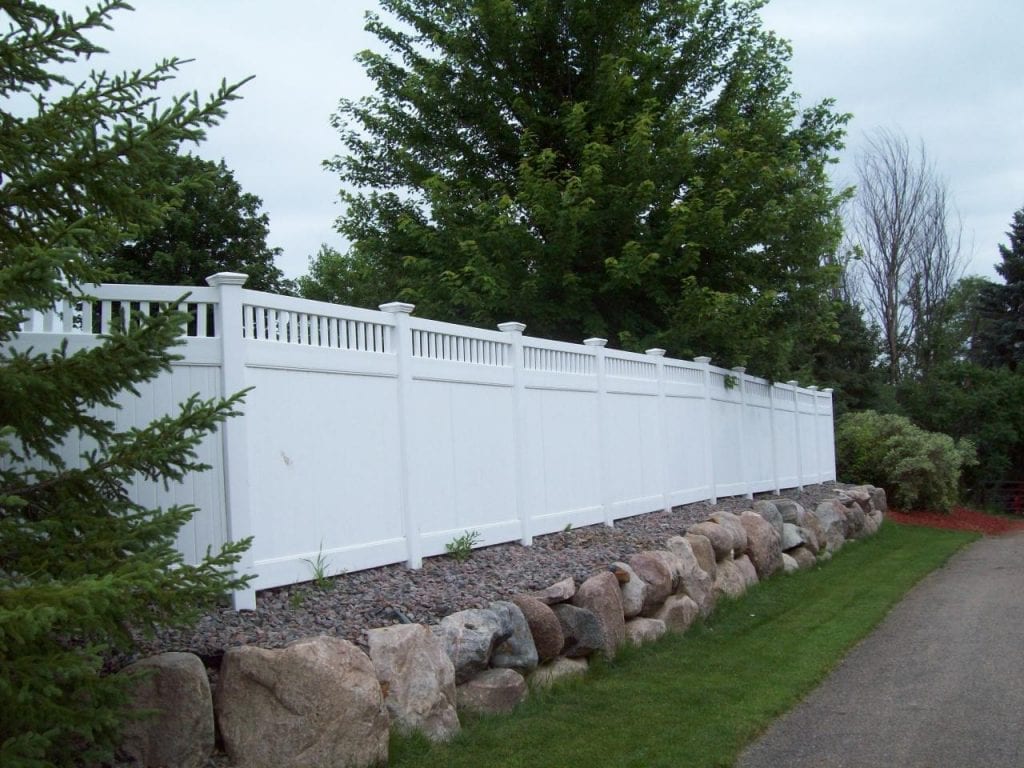We talk a lot about fence maintenance here at Northland Fence. There’s a pretty simple reason for that — we love fences. We want our clients or readers to have all of the knowledge and tools needed to keep their fences in the best condition possible so that there is no need to replace them year in and year out.
Installing a fence isn’t a small feat. It’s a pretty hefty project that can take up some time and energy to plan and complete. Even if you get professionals like us to install your fence for you, we’re not going to be there to help you maintain it.
So whether you’re thinking about installing a fence, or a chain link privacy fence, or maintaining your existing enclosure — you’re in the right place. We’re going to give you all of the information you need to know about in order to keep your fence standing tall all year round.
Which Fences Are The Easiest To Maintain?
Not all fences are created equal. Fences come in all shapes, sizes, and materials — some of these materials are far easier to deal with than others. If you don’t want to spend hours on end scrubbing, scraping, painting, or maintaining your fence then pay attention. You may have your heart set on a certain fence type, but we’re going to give you a bit of a reality check.
So what makes a fence easy to maintain? Well, one of the bigger hurdles for fence owners is keeping it clean. Dirt and debris look bad enough, but over time these eyesores can actually severely damage the integrity of the fence. If a fence is difficult to clean, it’s not going to be very easy to maintain. Another potential issue is how susceptible a fence is to weathering. Moisture is your fence’s arch-nemesis. Natural materials like wood are more difficult to maintain because moisture can lead to rot. Another maintenance bit is how durable a fence is. If a fence is made of metal, you’ll have to be mindful of scratches or scrapes because these can lead to rust.
As you can see there’s a lot of variables that can play into how easy a fence is to maintain. Take into consideration things like climate, small children, pets, and functionality when shopping for your future fence because all of these can affect the longevity of your enclosure. So, which fence types are the easiest to maintain over time? We’re glad you asked.
1. Vinyl
At the top of our list of easiest to maintain fences is vinyl. Not only is this material durable but it also looks great. The smooth finish makes it easy to clean and the strength of the material means that you won’t be looking at too many repairs (if any at all). You also don’t need to regularly paint vinyl which is a major plus.
2. Ornamental Fences
A traditional ornamental fence was composed of a wrought iron fence, which is actually a nightmare to maintain. That’s why most fence companies like ours use alternative metals to provide the same look without the hassle. Galvanized steel is our material of choice for its incredible strength and ability to be coated with a finish that won’t be susceptible to peeling, scrapes, or blistering paint.
3. Chain Link
Our last, but not least, easy to maintain fence type is chain link. Now, there are two materials we offer here. One is galvanized steel, which is maintained similarly to the ornamental version we mentioned above. The other is black vinyl coated steel wire. The way chain link fences are structured makes them less durable than traditional fencing, and the way the links intersect means that cleaning them can be a bit of a chore. That being said, they still rank in the top 3 for easiest to maintain.
Stay Away From Cedar
While most wooden fences are pretty tough to maintain and fall pretty low on our list, cedar presents a bunch of unique hurdles. Firstly, it’s a soft wood and is pretty cheap compared to other types of wood. Cedar posts also get swallowed up by water and moisture over time, which inevitably leads to rot. This means you’ll be replacing these in no time. It’s also a chore to paint and prime and has a lot of trouble with scratching and scraping. Wooden fences attract pests as well, so you’ll have to be ready for those. Cedar is also pretty inconsistent, meaning one batch may be extremely strong and the next may be weak. It’s almost a toss-up. That’s why we recommend that you steer clear from cedar and choose an alternative wood if you’re dead set on a wooden fence.
How To Maintain Your Fence
If installed properly, your fence won’t require a ton of maintenance. That being said, you can’t just put up a fence and be done with it. If you want a long lifespan for your enclosure there are certainly some steps you can take to make this a reality.
Earlier this summer, we created an “Annual Fence Maintenance Checklist” that can help act as a basic guide for those looking to get the most out of their fence. Most fences don’t really require any sort of weekly or even monthly upkeep (although you can if you want). That’s why we stuck with a nice little annual guide with some yearly maintenance tips for fence upkeep. But, if you keep on reading we’re going to go over all the steps you need to take to keep your vinyl, ornamental, and chain-link fences in great condition.
Vinyl Fence Maintenance
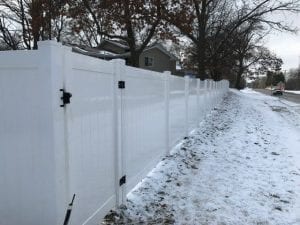
If you have already decided to go vinyl or plan to in the future, you have chosen wisely. As we mentioned earlier, this is the easiest to maintain fence type and will definitely give you the least amount of grief over its lifespan.
The first and easiest step in almost any fence maintenance guide is all about keeping it clean. Inspect your fence for any spots that might look dirty. For the most part, you can get away with a simple spray-down with your garden hose for removing light dirt, pollen, dust, or residue that might be sitting on the surface of your fence. If you notice that some corners or edges aren’t getting the attention they need, grab a sponge and some soapy water.
Note: Do not use an abrasive cleaner or scouring pads. These are rough enough to scratch, scrape, or damage the vinyl finish. Instead, opt for sponges or soft rags when wiping down your vinyl fence.
If you notice tough stains you’re going to need a bit more effort to get rid of them. For grease stains, rubber marks, tar, or just deep discoloration — we recommend mineral spirits with a soft cotton cloth. This should help break down the stain and restore your fence to its former glory. If these stains are stubborn and won’t give, try holding the solution soaked cloth on the stain for about 30 seconds, this should do the trick. Always wear rubber gloves and goggles when handling chemicals or irritants to protect yourself.
Some stains require a different approach. If you notice green, yellow, or black patches — you could be looking at mildew or algae staining. Water and soap do very little to get rid of these pesky stains, mostly because you need to kill them so that they don’t return later on. This is what makes these so darn stubborn. You may get them to disappear with a hose, but unless you kill the source they are likely to return with a vengeance.
- Fill a bucket up with about a gallon of water
- Pour a cup of chlorine bleach (or white vinegar if you want an organic solution) into the bucket of water
- Pour a half-cup of liquid soap detergent into the solution
- Mix well
- Soak a sponge in your solution and get to work
We said it once but we’ll say it again — use rubber gloves and goggles to protect yourself when handling chemicals. Algae stains are usually from grass clippings, so if you want to prevent these down the road just be sure to keep grass clippings off of your fence.
For those of you with some pretty massive enclosures, a bucket and sponge may not be your most efficient option. Grab yourself a power washer, the pressure alone should get rid of any light debris, dirt, or stains. But if you still notice some tougher stains like the ones we mentioned earlier, you can create a solution that will keep your fence in great condition. Concentrated all-in-one detergents that are made for power washers should be all you need. Just be sure to use something to protect your face.
Note: When using a power washer on your fence, use the wide spray nozzle or setting to prevent any damage to the vinyl. Use at an angle for the least amount of pressure and blowback.
We would mention other steps you can take here, but to be quite honest that’s all you need. Vinyl doesn’t need to be painted or sanded down, it won’t rust or warp, splinter or rot. It really is the easiest to maintain fence type.
Ornamental Fence Maintenance
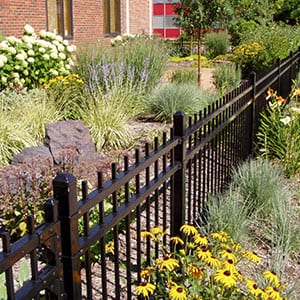
Next on the list is for our ornamental fence lovers. We know how important style and appearance is to you folks, which is why you decided to go with an ornamental fence in the first place. Well, if you want to maintain that look and feel — you’ll need to know all of the ways you can maintain your enclosure to keep it looking great and living longer.
The first step is always an inspection. Give your fence a once over every month or so. This is especially true for states like Minnesota where weather is so extreme. As a matter of fact, anywhere with extremely high or low temperatures, lots of snow, or even road salts from those icy days should inspect their ornamental fence more often. What exactly are you looking for? Well, certainly any debris or dirty spots that could use a good cleaning. For fences with a solid paint job and finish all you’ll need to do is wipe it down with water and a towel. If you notice any animal droppings or salt on your fence, use paint-safe soap and water.
But what you’re really on the lookout for are scratches, peeling, or scrapes in the paint of your ornamental fence. Your paint is the barrier that protects the steel or alternative metal from the elements. If this barrier is broken, you risk corrosion and rust. To prevent weathering, be extra diligent when inspecting your fence and take care of spots that are flaking, peeling, scratched, or chipped right away. Here’s how you can do that.
- Use a wire brush to clean away any damaged paint
- Apply two coats of primer to the affected area
- Apply two coats of rust-proof paint
Because paint is your main source of defense, it’s important to keep your coats intact. Ornamental fences are meant to look gorgeous. If you want to preserve this beauty and aesthetic, you’ll want to do all that you can to prevent any rust or corrosion issues from ever occurring. If you do notice rust, be sure to take care of it right away. All you’ll need to do is use a wire brush to sand down the affected area down to the metal. Use rust mort to restore the area. Then it’s all about priming and painting, so just follow the steps above.
Chain Link Fence Maintenance
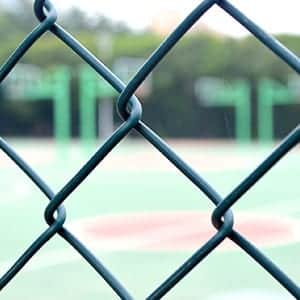
The final fence type on our all-encompassing guide to fence maintenance is the good ole chain link fence. While these fences don’t typically require too much upkeep they and aren’t necessarily renown for their aesthetic appeal — you don’t want a rusty or janky looking chain link fence. Because chain link and ornamental fences are constructed with similar materials, the cleaning process is fairly similar. However, there are some differences that you might find helpful.
Inspect your fence and the posts for any wear and tear, dirt, or rust. If you do see any dirt or debris, a simple cleaning should suffice. Like with all fence types, this is a preventative solution to keep your fence standing tall. Although it’s a simple step, it’s an important part of maintaining your chain link fence. For light debris or dirt, a quick hose down is all you’ll need. You can use soapy dishwater or a borax/water solution (for a more environmentally safe option) in an outdoor pump sprayer for tougher stains or animal droppings. Let the solution sit on the fence for about ten minutes and then hose it off. If you see some areas that need require extra care and precision, wear some gloves and use a sponge to wipe them clean.
Mold can form as well. If you notice this, we recommend using a white spirit vinegar and water solution. Use gloves and eye protection when spraying this on. Certain areas might need a bit more care and attention, so use gloves and a sponge to get into more difficult to reach crevices.
Depending on whether or not your chain link fence has a coating, certain areas may be more susceptible to rust than others, so be on the lookout there. Tackling rust early on will save you a ton of time, energy, and money down the line. If you’re extra diligent about looking for rust, you may catch it before you need to use any sort of chemical rust remover. If you do, simply use some steel wool to brush it away. Steel wool is no fun to handle without protection, so use rubber gloves and a bit of pressure to get rid of the beginning stages of rust. If the rust has gotten bad enough you may need to use commercial rust-remover. Follow the instructions and be sure to wear protection.
A Review
We covered quite a bit in this post, and we don’t want you to forget anything. When it comes to choosing the easiest to maintain fence type, we recommend going vinyl. These fences look great, last a long time, and don’t require you to paint, sand, or keep moisture away from them. Stay away from cedar if you want to avoid massive headaches, and if you do decide to go with an ornamental fence, make sure that it’s powder-coated galvanized steel.
While each fence type and material has its own maintenance steps that we covered, the basics remain the same. Keep your fence clean and free from dirt, animal droppings, or other unwanted debris that could cause issues down the road. With vinyl fences, be on the lookout for anything living like mildew or algae and make sure to kill it with the right solutions. For metal fencing, be sure that paint or coatings aren’t damaged — as this can lead to rust. If you do notice rust, take care of it right away.
Fence maintenance is a huge part of being a fence owner. No matter what type of fence material you have, you’re going to need to take some steps to maintain the integrity, look, and longevity of your enclosure. While some of these steps may seem like a lot of work, many of them can be prevented by regularly cleaning and inspecting your fence. If you are thinking about installing a new enclosure, feel free to contact us if you have any questions or want to get started.
